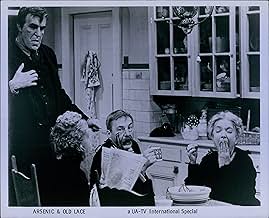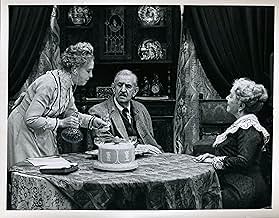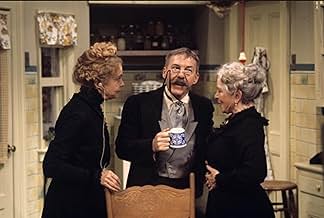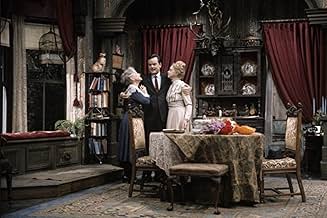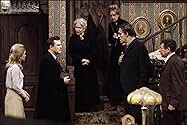A drama critic learns on his wedding day that his beloved maiden aunts are homicidal maniacs, and that insanity runs in his family.A drama critic learns on his wedding day that his beloved maiden aunts are homicidal maniacs, and that insanity runs in his family.A drama critic learns on his wedding day that his beloved maiden aunts are homicidal maniacs, and that insanity runs in his family.
Bob Crane
- Mortimer Brewster
- (as Robert Crane)
Richard Deacon
- Mr. Witherspoon
- (uncredited)
- Director
- Writers
- All cast & crew
- Production, box office & more at IMDbPro
Featured reviews
Let's get the obvious out of the way: this version of Arsenic and Old Lace is a live televised play with an audience who laughs, claps, and coughs. If you're not in the mood for that, stick to the original. This version is also kept in modern time, meaning 1969. The clothes and hairstyles, not to mention dancing, are groovy.
In this quirky comedy, a man visits his two elderly aunts to introduce his fiancé, but he's appalled to find they've murdered a man and hidden him in their window seat. It's very obviously based off a play, because most of the jokes are ones that would only go over well with a theatre audience. I didn't like the original, and I liked this version even less, because at least the original cut out some of the wordy passages. However, if you like Lilian Gish and Helen Hayes, and want to see them as the doddering old biddies, you can try it. Don't expect to make it all the way through, though.
In this quirky comedy, a man visits his two elderly aunts to introduce his fiancé, but he's appalled to find they've murdered a man and hidden him in their window seat. It's very obviously based off a play, because most of the jokes are ones that would only go over well with a theatre audience. I didn't like the original, and I liked this version even less, because at least the original cut out some of the wordy passages. However, if you like Lilian Gish and Helen Hayes, and want to see them as the doddering old biddies, you can try it. Don't expect to make it all the way through, though.
Saw this version of 'Arsenic and Old Lace' primarily for the cast, having liked much of the work of Helen Hayes, David Wayne, Fred Gwynne and particularly Lillian Gish. Also like the source material very much and have always gotten much enjoyment out of the 1941 film. Haven't seen the Boris Karloff version for a long time, but also remember that being much better than this version. And of course it is always interesting seeing an old live performance of any play (same with ballet and opera).
1969's 'Arsenic and Old Lace' could and should have been a lot better considering the cast and source material. It fares poorly as an adaptation and in comparison to the film, and also fails on its own. All the cast deserved better, with the performances being a very mixed bag (and even the few that came off well have been better), and the truncations, changes and rewrites that the play undergoes here works against the production significantly. There have been old filmed productions that have held up well and don't feel stagy, but this 'Arsenic and Old Lace' is not one of those productions.
There are certainly good things, with most of the rating going to a few of the performances. Gwynne seems to be enjoying himself thoroughly, does ominous chillingly and seems to know what the production was going for and how to approach the material. Same goes for splendidly dotty Hayes, and Billy DeWolfe is also a lot of fun. The best performance though goes to an amusingly befuddled Bob Crane.
Did like the costumes, which were elegant and not too fussy. The ending is quite well done.
Not much else is though. Love Gish as an actress, but she proves here that she worked better in drama than comedy and didn't find her dotty or sinister enough. Would have liked more chemistry between her Hayes, which came over as static. Jack Gilford is too sympathetic as well as overplays and Wayne come over as far too hammy and manic, actually felt embarrassed for Wayne who makes a ridiculous role incredibly annoying. Sue Lyon is bland and has nothing to do. The whole cast chemistry is too static and doesn't connect really enough, which gives a bland feel throughout.
Other than the costumes, the production looks cheap. Especially the poorly lit and pointless exteriors, while the sets are pretty cardboard-like. The camera work lacks focus and is too restricted and while it was interesting to hear the audience reactions they actually distracted and killed the momentum. The staging never comes to life properly and lacks wit and charm, even any menace doesn't come out enough and it is because everything comes over as too hammy.
The dialogue doesn't work as well, with a very bland and stilted feel and the rewrites jar, with the repeated Jonas Salk introducing being very repetitive and most are anachronistic. There is a lack of wit and there is nothing really that is funny. Updating the setting was also a mistake, adds nothing and makes some of the material feel very outdated, the play's setting is actually specific and as a result the Roosevelt jokes make no sense. With it being so truncated and changed, coherence was sometimes an issue.
Concluding, a waste of potential. 4/10.
1969's 'Arsenic and Old Lace' could and should have been a lot better considering the cast and source material. It fares poorly as an adaptation and in comparison to the film, and also fails on its own. All the cast deserved better, with the performances being a very mixed bag (and even the few that came off well have been better), and the truncations, changes and rewrites that the play undergoes here works against the production significantly. There have been old filmed productions that have held up well and don't feel stagy, but this 'Arsenic and Old Lace' is not one of those productions.
There are certainly good things, with most of the rating going to a few of the performances. Gwynne seems to be enjoying himself thoroughly, does ominous chillingly and seems to know what the production was going for and how to approach the material. Same goes for splendidly dotty Hayes, and Billy DeWolfe is also a lot of fun. The best performance though goes to an amusingly befuddled Bob Crane.
Did like the costumes, which were elegant and not too fussy. The ending is quite well done.
Not much else is though. Love Gish as an actress, but she proves here that she worked better in drama than comedy and didn't find her dotty or sinister enough. Would have liked more chemistry between her Hayes, which came over as static. Jack Gilford is too sympathetic as well as overplays and Wayne come over as far too hammy and manic, actually felt embarrassed for Wayne who makes a ridiculous role incredibly annoying. Sue Lyon is bland and has nothing to do. The whole cast chemistry is too static and doesn't connect really enough, which gives a bland feel throughout.
Other than the costumes, the production looks cheap. Especially the poorly lit and pointless exteriors, while the sets are pretty cardboard-like. The camera work lacks focus and is too restricted and while it was interesting to hear the audience reactions they actually distracted and killed the momentum. The staging never comes to life properly and lacks wit and charm, even any menace doesn't come out enough and it is because everything comes over as too hammy.
The dialogue doesn't work as well, with a very bland and stilted feel and the rewrites jar, with the repeated Jonas Salk introducing being very repetitive and most are anachronistic. There is a lack of wit and there is nothing really that is funny. Updating the setting was also a mistake, adds nothing and makes some of the material feel very outdated, the play's setting is actually specific and as a result the Roosevelt jokes make no sense. With it being so truncated and changed, coherence was sometimes an issue.
Concluding, a waste of potential. 4/10.
I was really interested in seeing this just on the basis of the actors, and also because I've seen it twice onstage, once with a TV-oriented cast (Jonathan Frid, Gary Sandy, Jean Stapleton, Marion Ross, Larry Storch). This 1969 version has its moments, and Bob Crane and Fred Gwynne are both noteworthy and hold up their end of the bargain, but it's still more or less lukewarm as a production. I see that there's yet another TV version with Tony Randall as Mortimer and Boris Karloff(!) as Jonathan... I'd love to get my hands on that one, if only to compare it against the other versions. In short, this 1969 version is a curiosity and mildly entertaining, but nothing to toast with a glass of elderberry wine.
The 1969 TV special "Arsenic and Old Lace" is the second TV version of this classic stage comedy; the first was televised on January 5, 1955 as an episode of "The Best of Broadway". The 1955 TV version had an excellent cast, with Boris Karloff and John Alexander repeating their Broadway roles as Jonathan and Theodore Brewster, plus Peter Lorre and Edward Everett Horton reprising their roles from Frank Capra's film version. Helen Hayes, who starred as Abby Brewster in the 1955 TV production of "Arsenic and Old Lace", repeats her role (and her half-baked performance) in this 1969 version.
A lot of bad decisions are made here. The play has been updated from the 1940s to the 1960s, which kills several topical jokes about the Roosevelts in the White House and Theodore Roosevelt's daughter Alice Longworth. Somebody decided to "open up" the action with some exterior scenes which weren't in the original play, such as when Mortimer Brewster goes to a nearby park to meet Witherspoon, the director of the Happy Dale insane asylum. Richard Deacon, usually a splendid character actor and a deft hand at comedy, gives a leaden performance as Witherspoon. The brief exterior sequences are badly photographed, in glaring sunlight.
The strangest mistake is the decision to rename Jonathan Brewster's henchman, the drunken plastic surgeon who accidentally carved up Jonathan's face to make him look like Boris Karloff. In the play and the movie (and the 1955 TV version), this character is named Herman Einstein, a name which sounds naturally funny and gets an automatic laugh when he's introduced as "Dr Einstein". But in this 1969 TV version, Jonathan's henchman has been re-named Jonas Salk (the same name as the real-life virologist who developed a vaccine for polio). Jonathan Brewster keeps introducing his henchman to the other characters as "Doctor Jonas Salk ... no relation". The line isn't funny the first time we hear it, and it's even less funny the third time. Dr Salk (formerly the Peter Lorre role) is played by Jack Gilford, a veteran character actor who's grossly miscast here: Gilford is much too sympathetic as an accomplice to a psychopathic murderer.
The best performance is Fred Gwynne's as Jonathan Brewster, the menace who goes homicidal every time someone tells him he looks like Boris Karloff. Gwynne spent his entire post-"Munsters" career trying to escape the spectre of Herman Munster, so I'm surprised that he took the role of Jonathan Brewster, with its obvious Herman Munster overtones. Do the maths: Jonathan Brewster = Boris Karloff = Frankenstein's monster = Herman Munster.
David Wayne, cast as Teddy Brewster (the lunatic who thinks he's Theodore Roosevelt) is too manic: Wayne seems to be playing a sane man PRETENDING to be crazy, whereas Teddy Brewster is a lunatic who seems outwardly normal. Also, David Wayne (unlike his predecessor John Alexander) doesn't look like Theodore Roosevelt, and this is fatal to his performance.
Bob Crane (formerly of "Hogan's Heroes") gives a competent performance as Mortimer Brewster, the only sane member of the family ... but his casting throws a chill across this production, for ironic reasons. During the climax of the story, when Mortimer is bound and gagged while Jonathan and Doctor Salk discuss the best way to kill him, modern viewers can't help recalling that (several years after this TV special was filmed) the actor Bob Crane was found murdered, his corpse bound with electrical flex. This is one of those scenes that's creepy for the wrong reason, like the moment in "Monkey Business" when Groucho Marx threatens to lock Thelma Todd in the garage. (Three years later, Todd was murdered in her garage.)
I can't think of any reason to recommend this version of "Arsenic and Old Lace". There are some good actors here, but they've all given better performances elsewhere. Skip this TV version and watch the Capra movie instead. The Capra movie has its own flaws, but overall it's superior to this production.
A lot of bad decisions are made here. The play has been updated from the 1940s to the 1960s, which kills several topical jokes about the Roosevelts in the White House and Theodore Roosevelt's daughter Alice Longworth. Somebody decided to "open up" the action with some exterior scenes which weren't in the original play, such as when Mortimer Brewster goes to a nearby park to meet Witherspoon, the director of the Happy Dale insane asylum. Richard Deacon, usually a splendid character actor and a deft hand at comedy, gives a leaden performance as Witherspoon. The brief exterior sequences are badly photographed, in glaring sunlight.
The strangest mistake is the decision to rename Jonathan Brewster's henchman, the drunken plastic surgeon who accidentally carved up Jonathan's face to make him look like Boris Karloff. In the play and the movie (and the 1955 TV version), this character is named Herman Einstein, a name which sounds naturally funny and gets an automatic laugh when he's introduced as "Dr Einstein". But in this 1969 TV version, Jonathan's henchman has been re-named Jonas Salk (the same name as the real-life virologist who developed a vaccine for polio). Jonathan Brewster keeps introducing his henchman to the other characters as "Doctor Jonas Salk ... no relation". The line isn't funny the first time we hear it, and it's even less funny the third time. Dr Salk (formerly the Peter Lorre role) is played by Jack Gilford, a veteran character actor who's grossly miscast here: Gilford is much too sympathetic as an accomplice to a psychopathic murderer.
The best performance is Fred Gwynne's as Jonathan Brewster, the menace who goes homicidal every time someone tells him he looks like Boris Karloff. Gwynne spent his entire post-"Munsters" career trying to escape the spectre of Herman Munster, so I'm surprised that he took the role of Jonathan Brewster, with its obvious Herman Munster overtones. Do the maths: Jonathan Brewster = Boris Karloff = Frankenstein's monster = Herman Munster.
David Wayne, cast as Teddy Brewster (the lunatic who thinks he's Theodore Roosevelt) is too manic: Wayne seems to be playing a sane man PRETENDING to be crazy, whereas Teddy Brewster is a lunatic who seems outwardly normal. Also, David Wayne (unlike his predecessor John Alexander) doesn't look like Theodore Roosevelt, and this is fatal to his performance.
Bob Crane (formerly of "Hogan's Heroes") gives a competent performance as Mortimer Brewster, the only sane member of the family ... but his casting throws a chill across this production, for ironic reasons. During the climax of the story, when Mortimer is bound and gagged while Jonathan and Doctor Salk discuss the best way to kill him, modern viewers can't help recalling that (several years after this TV special was filmed) the actor Bob Crane was found murdered, his corpse bound with electrical flex. This is one of those scenes that's creepy for the wrong reason, like the moment in "Monkey Business" when Groucho Marx threatens to lock Thelma Todd in the garage. (Three years later, Todd was murdered in her garage.)
I can't think of any reason to recommend this version of "Arsenic and Old Lace". There are some good actors here, but they've all given better performances elsewhere. Skip this TV version and watch the Capra movie instead. The Capra movie has its own flaws, but overall it's superior to this production.
It's hard, if not impossible, to remake a classic. Since its theatrical release in 1944 only one attempt has been made to remake Frank Capra's "Arsenic and Old Lace and the fact that it came in the form of a "made for TV" movie made it seem, at first glance, even greater sacrilege. The production is, nonetheless, first class. Bob Crane (Hogan's Heroes) just shines as the befuddled newlywed Mortimer Brewster, suddenly confronted with the fact that his gene pool was more like a fetid DNA swamp of psychotic chromosomes. Careful updating of the original play only served to make it perhaps more appealing to contemporary audiences without detracting from the perfection of its predecessor. Casting was beyond reproach. Who could possibly protest Lillian Gish and Helen Hayes as the sweet, dotty albeit homicidal aunts or Fred Gwynne as the ominous brother Jonathan. This version is seldom if ever shown but if you ever get a chance to see it, do. It is an updated interpretation of the original and every bit as good.
Did you know
- TriviaHelen Hayes had previously played Abby in a television broadcast on January 5 1955.
- ConnectionsReferenced in Chapeau melon et bottes de cuir: Homicide and Old Lace (1969)
Details
- Release date
- Country of origin
- Language
- Also known as
- Arsénico por compasión
- Production company
- See more company credits at IMDbPro
Contribute to this page
Suggest an edit or add missing content

